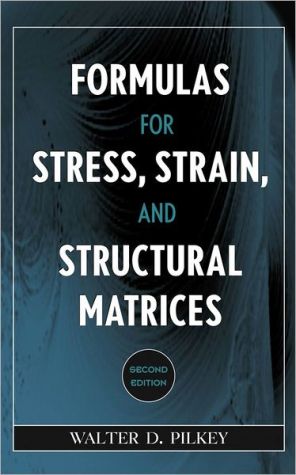Formulas for Stress, Strain, and Structural Matrices
Formulas for Stress, Strain, and Structural Matrices, Second Edition presents and classifies data related to all the applications of stress and strain analysis in a handy and useful single-source reference. Delivering key material not found in other books on the subject, this updated edition enables readers to harness the efficiency and accuracy of today's computers for deformation and stress analysis.
Search in google:
A single-source reference covering all aspects of formulas for stress and strainFormulas for Stress, Strain, and Structural Matrices, Second Edition presents and classifies data related to all the applications of stress and strain analysis in a handy and useful single-source reference. Delivering key material not found in other books on the subject, this updated edition enables readers to harness the efficiency and accuracy of today's computers for deformation and stress analysis.This versatile Second Edition provides the critical information needed to identify the responses of general mechanical elements and structural members, as well as to find simple formulas that are organized by member type to facilitate the solution of more complex members. Formulas are given for stresses, displacements, buckling loads, natural frequencies, transient responses, beams, torsional systems, extension bars, frames, thin-walled beams, curved bars, rotors, plates, thick shells, and thin shells. The tables of structural matrices are powerful tools for developing custom computer programs to solve special problems.Formulas for Stress, Strain, and Structural Matrices, Second Edition features:New material on biomechanics, biomaterials, viscoelasticity, nanotechnology, MEMS, and material selectionExtensive geometries or load cases for different structural membersStiffness matrices enable readers to quickly and easily construct their own computer solutionsFormulas for dynamic response and free vibrationBackground material on stress and strain, mechanical properties of materials, stress analysis, stress concentration, and fracture and fatigue mechanicsA conveniently organized resource for the strength of material formulas, Formulas for Stress, Strain, and Structural Matrices, Second Edition eases the task of analysis and provides critical information for mechanical, design, civil, and structural engineers as well as stress analysts. Booknews For design engineers, this source book provides the important formulas, equations, and figures for stress analysis and the design of structural elements. The volume is organized in tabular form and uses uniform nomenclature. Key areas presented include: thermal stress and dynamics; formulas for stresses, displacements, buckling loads, natural frequencies, and transient responses, as well as for beams, torsional systems, extension bars, frames, thin-walled beams, curved bars, rotors, plates, thick shells, and thin shells; and mechanical properties and testing of engineering material, including geometric shear-related properties and stresses, responses of gridworks and thick shells, and fracture mechanics and fatigue. Annotation c. Book News, Inc., Portland, OR (booknews.com)
1Introduction12Geometric properties of plane areas173Stress and strain894Mechanical properties and testing of engineering materials1495Experimental stress analysis2356Stress concentration2557Fracture mechanics and fatigue3078Joints3699Contact stresses41310Dynamic loading45111Beams and columns51912Torsion and extension of bars61913Frames66114Torsion of thin-walled beams73315Cross-sectional stresses : combined stresses76316Curved bars80117Rotors89118Plates97719Thick shells and disks113120Thin shells1185App. IFundamental mathematics1319App. IIStructural members1369App. IIIStructural systems1405
\ BooknewsFor design engineers, this source book provides the important formulas, equations, and figures for stress analysis and the design of structural elements. The volume is organized in tabular form and uses uniform nomenclature. Key areas presented include: thermal stress and dynamics; formulas for stresses, displacements, buckling loads, natural frequencies, and transient responses, as well as for beams, torsional systems, extension bars, frames, thin-walled beams, curved bars, rotors, plates, thick shells, and thin shells; and mechanical properties and testing of engineering material, including geometric shear-related properties and stresses, responses of gridworks and thick shells, and fracture mechanics and fatigue. Annotation c. Book News, Inc., Portland, OR booknews.com\ \








